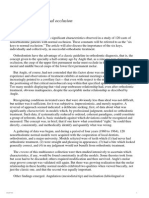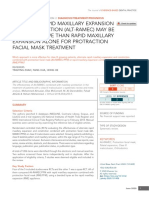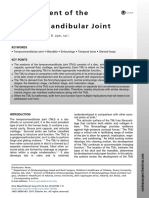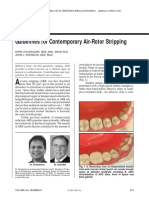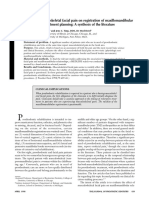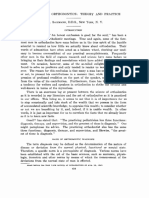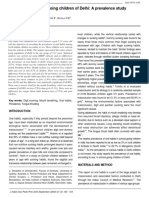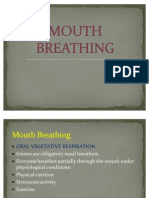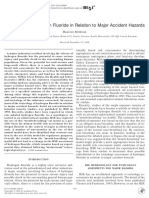Pressure Habits, Etiological Factors in Maloccclusion
Pressure Habits, Etiological Factors in Maloccclusion
Uploaded by
Margarita Lopez MartinezCopyright:
Available Formats
Pressure Habits, Etiological Factors in Maloccclusion
Pressure Habits, Etiological Factors in Maloccclusion
Uploaded by
Margarita Lopez MartinezOriginal Title
Copyright
Available Formats
Share this document
Did you find this document useful?
Is this content inappropriate?
Copyright:
Available Formats
Pressure Habits, Etiological Factors in Maloccclusion
Pressure Habits, Etiological Factors in Maloccclusion
Uploaded by
Margarita Lopez MartinezCopyright:
Available Formats
AJO-DO on CD-ROM (Copyright 1998 AJO-DO), Volume 1952 Aug (569 - 587): Pressure habits, etiological factors in maloccclusion
n - Klein
PRESSURE HABITS, ETIOLOGICAL FACTORS IN
MALOCCLUSION
ERNEST T. KLEIN, D.D.S.
DENVER, COLO.
THERE is no tissue in the human body which the orthodontist should know and understand
more intelligently than living bone. "Although living bone feels hard and rigid to the touch of the
hand, it is the most plastic structure in the whole organic complex and should be so considered by
the orthodontist."1
Bone is an ever-changing tissue that constantly is being repaired and replaced from infancy to old
age. Sicher2 tells US that, although bones are permanent structures in our bodies and although we
have no more bone at any part of our bodies than is reasonably needed plus a certain amount for
marginal safety, constant daily repair goes on just as it does in our famous cathedrals. Scaffolds
always can be seen on the sides of these cathedrals where workmen are replacing defective stones
with solid ones, so that the structure is in constant repair. In like manner, bone constantly is being
repaired and replaced. Sicher believes that one cannot grow or destroy bone but merely stimulate it.
He says that bone never grows under pressure but that cartilage grows under pressure and, in turn, is
replaced by bone. Sir Arthur Keith3 declares, "Osteoblasts at all times build or unbuild according to
the stress to which they are subjected." On the other hand Wolff 16 believed that pressure, not
tension, is the cause of bone development. The amount of growth in bone depends upon the need for
it.
Although bone is extremely susceptible to the guidance and influence of pressure and stimulus,
the extent to which bone can be changed with pressure or stimulus is controversial. Conservative
authorities on bone growth believe that orthodontic treatment (intentional pressure) cannot change
basal bone; due to the hereditary factor, the pattern of the basal bone remains the same. However,
even the most conservative group will agree that alveolar bone can be changed and the teeth in that
bone regulated with orthodontic treatment. Pressure habits (unintentional pressures) also change
alveolar bone and move teeth in that bone because the bone-building cells on the receiving end of
the stimulus cannot differentiate whether that stimulus is intentional (planned orthodontic
treatment) or whether it is unintentional (abnormal pressure habit) . Since changes take place in the
bone whether the stimulating factor is intentional or unintentional, one cannot deny pressure habits
as an etiological factor in malocclusion without denying the accepted principle of planned
orthodontic treatment.
Occipital and parietal bones of the skull hold the brain case, are hard, and can stand pressure,
while the face, with its cartilaginous bone, yields easily to stimulus and pressure, especially during
growth spurts, and presents the most complicated growth problem in the entire skeleton since the
greatest growth changes in the head are made by the facial structures. Strang 4 states: "The face
increases in size about 12 times from birth to adolescence, while the cranium increases only about
Article Text
AJO-DO on CD-ROM (Copyright 1998 AJO-DO), Volume 1952 Aug (569 - 587): Pressure habits, etiological factors in maloccclusion - Klein
four times." Since the greatest growth changes in the head are being made by the facial structures, it
logically can be assumed that all abnormal pressures should be kept from this most vulnerable
target, the face. It is during the transition from the deciduous to the permanent arch that much of the
damage takes place, and it is during this transition stage that the avoidance of all abnormal pressure
habits is of the utmost importance. One may argue that oftentimes children with abnormal pressure
habits have well-developed faces and have no malocclusion, and how then can these same habits
cause facial abnormalities in other children? Fluhrer 5 gives this explanation: Healthy bone grows
and is influenced by environmental factors such as abnormal pressure habits. Bone that has a
"disturbance in ossification, caused by ill-health, improper diet, or endocrine disturbances resulting
in 'bone fatigue' does not grow and consequently is not changed by environmental factors such as
abnormal pressure habits. The latter cases are the exception rather than the rule." By the same
token. it may be explained why some cases of malocclusion respond to planned orthodontic
treatment while others with the same malocclusion and receiving the same planned orthodontic
treatment do not.
All pressures fall into one of two classifications, either intentional or unintentional. The
intentional are the planned pressures, and the unintentional are the abnormal pressure habits. The
unintentional or abnormal pressure habits are of three types: (1) intrinsic or pressure habits within
the mouth; (2) extraneous or extrinsic, abnormal pressure habits on the face; and (3) functional
pressures.
The effects of pressure habits on bone have been known to the orthodontic profession for a long
time. Intrinsic pressure habits such as thumb-sucking, finger-sucking, lip biting, tongue thrusting,
mouth breathing, etc., were recognized as harmful, and efforts were made to eliminate the habits
long before the extraneous (extrinsic) pressure habits such as chin propping, face leaning on
forearm or hands, and abnormal pillowing positions were believed to aggravate malocclusion. As
early as 1903, George T. Baker 7 attributed a case of malocclusion to a sleeping habit in which the
child exerted constant pressure against the mandible. In 1920, Calvin Case 7 explained lateral
malocclusions by the pillowing habits of early infancy. While at Dr. Angle's school, Atkinson 6 was
perhaps one of the first to make mention of the possibility that "special sleeping habits" could cause
malocclusion. He was referring to extraneous (extrinsic) pressure habits such as chin propping, face
leaning on forearm and hands, and abnormal pillowing positions rather than the intrinsic pressure
habits which had been recognized and accepted for some time previous. Harvey Stallard, 7 who was
at Dr. Angle's school at the same time, was deeply impressed by the suggestion and, in the fall of
1920, made a personal survey of the sleeping habits of children. He first asked the parents how their
children slept, but he soon became convinced that parents are poor observers, and so he resorted to
making visits to bedsides to study personally those suspected of using extraneous pressure. After
studying some 300 individuals in their sleeping environment, he published a preliminary report in
the Dental Cosmos, 1923, of his conclusions that cross-bites and saddle-shaped and V-shaped
dental arches are the result of hand, arm, shoulder, and face pillowing. This probably was the first
extensive report on extraneous (extrinsic) pressure habits ever published.
William Roy Humphrey, 8 associated with the late Albert H. Ketcham from 1918 until Ketcham's
Article Text
AJO-DO on CD-ROM (Copyright 1998 AJO-DO), Volume 1952 Aug (569 - 587): Pressure habits, etiological factors in maloccclusion - Klein
death in 1936, recognized the importance of intrinsic pressure habits from the very beginning of his
orthodontic practice. Ever since Stallard made his first report on extrinsic pressure habits in the
Dental Cosmos of 1923, Humphrey has considered extrinsic pressure habits as an etiological factor
in malocclusion. He states, "After employing both uninterrupted and intermittent pressure in the
treatment of orthodontic cases for many years, I am of the opinion that if one does not include
external pressure habits (unintentional pressures) as an etiological factor in malocclusion, the entire
treatment concept of modern orthodontic therapy is denied. Of course, such an etiological factor as
pressure habit is often superimposed upon one or more of the following: nutritional factors,
endocrinopathies, untoward hereditary factors, pathological entities."
Alfred Paul Rogers,9 often-quoted authority on myofunctional treatment of malocclusion, in a
personal letter dated June 27, 1950, wrote: "It is a well recognized biological fact that structural
form is influenced by pressures due to abnormal neuro-muscular activity; the converse being true
that normal pressures, due to function, tend toward normal form in the osseous structures."
Johnson1 reached the same conclusion and is often quoted as saying, "Normal habits maintain
normal structural form; abnormal habits maintain abnormal structural form." Is it not logical,
therefore, to attempt to eliminate all al-normal habits (abnormal neuromuscular activity), all
pressure habits which tend to stimulate, develop, and maintain alveolar bone and the teeth in that
hone in abnormal structural form?
Since a picture can put an idea across more effectively than thousands of words, let us examine
some photographs that illustrate how pressures change living bone. These photographs illustrate
how pressures, whether intentional or unintentional, produce changes in living bone. An effort was
made to collect as much pressure habit data, from every available source, as possible.
CLASSIFICATION OF PRESSURE
I. Intentional pressure (planned pressures)
A. Orthodontic treatment appliances
B. Myofunctional therapy9
C. Intentional head deformation11 (Fig. 1)
D. Giraffe-necks of the Padaung women 12 (Fig. 2)
E. Chinese custom of foot binding13 (Fig. 3)
F. Reshaping horns of cattle 14 (Figs. 4 and 5)
II. Unintentional pressure (abnormal pressure habits)
A. Intrinsic pressure habits (within the mouth)
Article Text
AJO-DO on CD-ROM (Copyright 1998 AJO-DO), Volume 1952 Aug (569 - 587): Pressure habits, etiological factors in maloccclusion - Klein
1. Thumb-sucking (Fig. 6)
2. Finger-sucking
3. Tongue-sucking
4. Lip-sucking
5. Cheek-sucking
6. Blanket-sucking
7. Nail biting
8. Lip biting
9. Tongue biting
10. Tongue thrusting (Fig. 7)
11. Macroglossia, overgrowth of the tongue
12. Incorrect swallowing, anesthesia throat6,18,19 (Fig. 8)
13. Mouth breathing
B. Extraneous (extrinsic) abnormal pressure habits (face)
1. Chin propping (Fig. 9)
2. Face leaning on hand (Fig. 10)
3. Abnormal pillowing, positions, leaning on forearm or hand 8 (Figs. 11 and 12)
4. Habitually sleeping on the right side of the face may cause the nose to turn leftward or vice
versa; a deflected septum may also result from this sleeping habit 7
C. Functional pressures
1. Bowlegged cowboy (sprung legs) (Fig. 13)
2. Warping bones of the foot by wearing shoes that do not fit properly
3. Narrowing the external auditory meatus on one side by sleeping on that side of the head
more than on the other
4. Flattening of an infant's head by laying infant habitually in one position for prolonged
Article Text
AJO-DO on CD-ROM (Copyright 1998 AJO-DO), Volume 1952 Aug (569 - 587): Pressure habits, etiological factors in maloccclusion - Klein
periods. Today, mothers do not permit their babies to lie too long in one position but turn the
infants frequently.
5. Flattened Indian skulls, base of skull mushroomed over spinal column caused by carrying
heavy loads on their heads throughout their lifetime 6
6. Malocclusion frequently developed in musicians from pressure exerted on their teeth or face
7. Kyphosis or round shoulders common among dentists, school children, tailors, cobblers,
carpenters, and laborers, caused by occupational pressures
8. A bent and sometimes notched breastbone of chickens and turkeys that roost in trees from
the pressure exerted20
9. Spinal curvature can result from abnormal sleeping positions and postural irregularities 7
10. Many other occupational and functional pressures not mentioned.
Skulls of the Pueblo Indian Square Head and the Flathead Indians show the effect of pressure on
living human skulls. Fig. 1 demonstrates how the Flathead Indians tied their papooses to boards to
produce the flat heads which they admired.
Deformation of the human head has been known since the writings of Herodotus and was very
common among the Natchez Indians along the northeast coast of the Gulf of Mexico and the
northwest coast from South Oregon to Vancouver. It became fixed through long practice and was
considered a mark of distinction and superiority.
The effects of these various head deformations on brain function and growth as well as health of
the individual apparently are insignificant. The hereditary effects are perceptible; the deformation,
once acquired, persists throughout life. The custom of head deformation among the Indians is
gradually decreasing, and the indications are that in a few generations it will cease to exist.
Whereas the Indians warped the head bones intentionally, modern Americans warp their faces
and jaws unintentionally with abnormal pressure habits.
The Padaung women, Karen Group, who live in Burma, adjoining India on the Northeast, are
remarkable for the amount of brass wire used for coiling around their necks. They begin with five
coils as thick as the little finger and add more as the neck stretches until twenty-one coils are
reached. The weight of the metal is sometimes eighty pounds. The gradual addition of wire coils
around the neck produces a pressure and an elongation of the individual's neck, causing that
individual to become ''giraffe-necked.''12 (Fig. 2.)
Foot binding was prohibited by the new laws of the Chinese Republic in 1921. The custom was
more than seven centuries old and originated from the desire of men to keep their women from
running away.
Article Text
AJO-DO on CD-ROM (Copyright 1998 AJO-DO), Volume 1952 Aug (569 - 587): Pressure habits, etiological factors in maloccclusion - Klein
At one time, unbound feet were taxed heavily today, bound feet are taxed, the money being
used to support schools for young girls throughout China. No longer do small girls shriek with pain
as their feet are tightly bound because this ancient custom is being stamped out stamped out
partly by a still older belief of Confucius that the physical body never should be mutilated or
destroyed. (Fig. 3.)
Many stockmen shape the horns of their stock for show by placing one-half-pound lead weights
on the tips of the horns of the animals when they are 8 to 10 months old. Treatment is intermittent
for two-week periods until the desired shaping has been attained, at which time the weights are
removed with no danger of relapse occurring. In case reshaping is not effective with one-half-pound
weights, the weights may be increased up to one-and-one-half-pound weights. The change in horn
position is not in the horn itself but at its growth sites where it is attached to the frontal bone. As
stated previously, once the horn is shaped, it does not relapse. ( Figs. 4 and 5.)
Horns are a protection but can be detrimental if not properly shaped. Packing houses sometimes
cut down as much as 25 per cent on cattle that have been injured by each other's horns. As a result,
many stockmen are breeding out horns producing hornless breeds. 14
Charles Waldo, 21 who conducted numerous experiments at Harvard University on deer's antlers,
reports that the horns of cattle are a permanent process of the frontal bone and are not shed like the
deer's antlers. They are composed of cancellous bone and grow in length chiefly at the base of the
horn while the antlers of the deer have a compact periphery and grow at their tips, leaving behind a
column of bone.
Albert H. Ketcham15 used to have some data on a held of seventeen long-horned steers shipped
from Texas to the Oklahoma Park Department. One of the animals was sent to a small park in
western Oklahoma where, after a few months, its horns drooped until they projected beyond its
nose. The animal could not eat and was killed. A subsequent analysis of the soil revealed a severe
mineral deficiency. In this case, the growth sites at the bases of the horns were affected and, as
usual, new bone was formed but it was poorly calcified and too soft to support the weight of the
horns, the weight of the horn itself causing it to droop downward.
It has been found that breastbones of chickens and turkeys can be prevented from being bent to
one side or becoming notched when the chickens and turkeys roost in trees if the birds are fed bone
meal, commercial limestone, and oyster shells, a diet rich in calcium. 20
These are examples of how two or more etiological factors sometimes are superimposed upon
each other.
Thumb-sucking habits, unintentional pressures (intrinsic), at all early age are a normal act;
continuation of the habit past the age of permanent dentition may cause a malocclusion (Fig. 6).
TONGUE HABITS
Article Text
AJO-DO on CD-ROM (Copyright 1998 AJO-DO), Volume 1952 Aug (569 - 587): Pressure habits, etiological factors in maloccclusion - Klein
The tongue is a powerful muscular organ which exerts tremendous pressure at frequent intervals,
twenty-four hours a day, during the nighttime as well as during the day.
In tongue thrusting habits (Fig. 7), a normal-sized tongue or one that is overdeveloped is thrust
between the upper and lower teeth each time the patient swallows, producing an open-bite.
Sometimes the patient allows the tongue to rest in the open-bite space between acts of deglutition,
preventing the bite from closing. Tongue thrusting also permits the molars to elongate, a condition
which further complicates the problem of correcting open-bite cases even if tongue thrusting habits
have been corrected.
In macroglossia, overgrowth of the tongue, pressure is exerted against the lingual surfaces of the
teeth, causing them to become spaced. Indentations on the tongue often appear where the tongue
pushes against the teeth. A sharp filling or tooth may cause a normal-sized tongue to travel to the
source of irritation so frequently that the tooth with the sharp point will move out of the line of
occlusion in the direction the tongue is pushing.
When you observe an open-bite or spacing of the teeth, examine the tongue for size as well as for
its behavior when in the act of swallowing or speaking. Invariably you will discover that the tongue
is being forced through the space which it undoubtedly produced in the first place. Test the palate
for "anesthesia throat."
Tongue sucking, tongue biting, tongue thrusting (Fig. 7) and other abnormal tongue habits, as
well as macroglossia, anesthesia throat (Fig. 8), and sharp fillings on teeth produce abnormal
pressures which can develop an openbite, spacing of the teeth, overdevelopment of the mandible, as
well as an unnatural position of the mandible and the condyle.
"ANESTHESIA THROAT"
"Anesthesia throat" is a term coined by C. F. Stenson Dillon 18 to describe a throat which has no
sensory nerve supply and is immune to sensation. The individual has no normal impulse to swallow
nor will she gag upon touching the uvula, velum palatinum, or any of the usual trigger points in the
throat. In order to swallow, she must seize the tongue between the anterior teeth and, by dint of
muscular contortions involving even the face (as illustrated in Fig. 8), perform the act of deglutition.
What chance has anyone to correct and maintain the correction of an open-bite under such
circumstances? One can determine this condition by watching closely the efforts of the patient to
swallow and then, by means of a mouth mirror, test the swallowing reflexes. Trouble,
disappointment, and much unrewarded effort can be avoided by this simple test.
INCORRECT SWALLOWING HABITS
The following clinical observation regarding improper swallowing habits is made by Atkinson 6 :
Hold your hand on the chin of the patient while the patient is in the act of swallowing. If the jaw
is opened during the act of swallowing, it is an indication that the swallowing is done improperly. If
Article Text
AJO-DO on CD-ROM (Copyright 1998 AJO-DO), Volume 1952 Aug (569 - 587): Pressure habits, etiological factors in maloccclusion - Klein
the jaw opens during the act of swallowing, the suprahyoid muscles will pull the body of the
mandible downward, bending it just anterior to the angle of the jaw, causing tendency for an
open-bite. If the jaws are closed during the act of swallowing, it is impossible to produce this
bending of the mandible just anterior to the angle of the jaw. Open-bites are all typical bent down
just anterior to the angle of the jaw.
Straub19 draws the following conclusions:
1. The perverted swallowing habit seems to be the direct result of improper bottle feeding.
2. The perverted swallowing habit may separate not only the anterior teeth but also most of the
posterior teeth including the premolars and, in rare instances, the first molar unilaterally.
3. In many perverted swallowers, the palate is so high and narrow that the child cannot place his
or her tongue in its correct position due to its size, even if the child wished to, until proper
corrections have been made.
4. The perverted swallowing habit may be present with other interference habits such as
thumb-sucking or finger-sucking, lip biting, tongue thrusting. nail biting, and leaning habits.
5. It seems to be more prevalent in the female than the male, but this should be discounted as
parents may be more concerned with slight irregularities in their daughters' rather than in their sons'
teeth.
6. The perverted swallowing habit should be detected and corrected early to facilitate normal
development of the palate and dentitions. In its early detection, it should be corrected immediately
with a mechanical appliance to limit the tongue to its proper position. It is a very difficult habit to
correct in older patients, and there is some danger that after fourteen to sixteen years of swallowing
incorrectly these patients may return to the old perverted swallowing habit alter all the appliances
have been removed.
Mouth breathing may also cause an open-bite. The nose is the air conditioning plant of the body,
and failure properly to condition the air we breathe produces harmful effects other than
malocclusion.
If there is a nasal obstruction, correction of this defect is imperative before the mouth breathing
habit can be corrected. In clinical examination, tip the patient's head back. Invariably you will
discover that the mouth breathers with nasal obstruction have narrow, undeveloped nares.
The late Bernhard Gottlieb17 made the observation that "Closed bites are rare among the people
who live in Europe. They rarely chew gum. Closed bites are very common in gum chewing
America. Gum chewing is done mostly on the posterior teeth which might cause them to depress
and further the eruption of the anterior teeth, developing excessive closed bite."
Like most discussions of a living problem in science, this observation ends, metaphorically, not
Article Text
AJO-DO on CD-ROM (Copyright 1998 AJO-DO), Volume 1952 Aug (569 - 587): Pressure habits, etiological factors in maloccclusion - Klein
with a full stop but with a question mark: "Is gum chewing a factor to be considered in closed bites?"
CHIN PROPPING HABIT
A chin propping habit (extraneous or extrinsic pressure, unintentional) will cause a deep anterior
closed bite as is illustrated in Fig. 9, and may also cause the mandible to be in retraction. Note how
little of the lower anterior teeth is visible when the jaws are in a closed position.
FACE LEANING
Lateral pressure from face leaning (extraneous or extrinsic pressure, unintentional) may cause a
lingual movement of the maxillary teeth on that side, the mandible being less affected because it
does not have a rigid attachment and can slide away from the pressure. Fig. 10 illustrates how the
mandible swings to the left with the pressure, the maxillary arch receiving the stimulus or pressure
on the right side.
Brodie12 observes, "Normally the mandible travels from its rest position to lull occlusion (a
distance of about 3 mm.) by strictly rotational movements, the condyle acting as a pure hinge. It is
only during this movement that the teeth can exert any influence on the mandible. If any tooth
interferes with the normal path of closure, the mandible is deflected, bringing undue stress on the
offending tooth and abnormal shifting of the condyle in the fossa. Such shifting may be in any
direction." Extraneous pressure habits such as chin propping (Fig. 9), face leaning on the hands
(Fig. 10), abnormal pillowing positions (Figs. 11 and 12), or abnormal tongue habits (Fig. 7) also
may guide the mandible and the condyle into unnatural positions.
When the mandible is moved from an abnormal position into a normal position and it functions
and is retained in this new position, it is considered having been positioned into normal function.
This process should not be referred to as "repositioning of the mandible" but as "positioning of the
mandible." The mandible is "positioned" when it functions normally, the condyle acting as a pure
hinge; the mandible is out of position and needs " positioning " if the mandible in its normal hinge
movement is deflected during its normal path of closure by some abnormal interference such as a
premature tooth contact or abnormal extraneous pressure habits. Humphrey 8 confirms this
observation.
The etiology of malocclusion is infinitely complex; and, although abnormal pressure habits
definitely are a factor that must be considered in the study of the cause of malocclusion, abnormal
pressure habits are by no means the complete answer to the orthodontist's problem. The etiology of
malocclusion is not as simple as that.
It is generally accepted that dental and facial deformities many be the result of many etiological
factors, such as hereditary factors, environmental factors, nutritional factors, endocrine dysfunction,
premature loss or prolonged retention of deciduous teeth, malformed or supernumerary teeth, loss of
permanent teeth, pathological entities, as well as abnormal pressure habits, all of which may
function singly or be superimposed upon each other.
Article Text
AJO-DO on CD-ROM (Copyright 1998 AJO-DO), Volume 1952 Aug (569 - 587): Pressure habits, etiological factors in maloccclusion - Klein
Heredity and environment are two very important active factors in the etiology of malocclusion.
Heredity is sealed when fertilization takes place. In other words, there are some patterns handed on
by our ancestors which cannot he changed thereafter. To be perfect, therefore, we must choose our
ancestors. There may be political equality but never biological equality. 23
Galton's law of bisexual heredity quotes the mathematical proportion that can be inherited from
our forefathers.16
1 /2
is derived from the parents
1 /4
is derived from the grandparents
1 /8
is derived from the great-grandparents
1/16
is derived from the great-great-grandparents, etc.
After heredity is sealed, the great environmental or acquired influences which include all the
pressures, intentional and unintentional, begin to play their part.
Although heredity has determined certain patterns so that the orthodontist is limited to what he
can hope to accomplish, heredity cannot be used as a wastebasket for his failures.
In discussing heredity and environment, A. LeRoy Johnson 1 says that an orthodontist never treats
the normal denture. He treats only abnormal eases in which normal development has been interfered
with. Use of a muse]e develops that muscle, and disuse soon causes it to atrophy. The question is
"Are these effects inherited?" Did the giraffe get his long neck because he browsed on trees, or did
he browse on trees because he had a long neck? The consensus of opinion is in favor of the second
of these alternatives.
Without underestimating the important position all factors hold in diagnosing the causes of
malocclusion, giving each factor the careful consideration it has earned and rightfully deserves,
abnormal pressure habits still should occupy a prominent place in the orthodontist's diagnostic
armamentarium.
When a patient asks the orthodontist whether or not orthodontic treatment is indicated and if he
will guarantee that he can establish a functional occlusion and maintain it without relapse, the
orthodontist is safe in stating that although a tooth that is not in function is a sick tooth, to the best
of his knowledge no one has ever died because he had "crooked teeth." He might then well ask
himself, "Am I capable of achieving the result the patient requires ? If this patient were my own
child, would I treat?" In all fairness, the orthodontist should then inform the patient that he feels that
he can or cannot develop or grow the malocclusion into functional occlusion duplicating the
guarantee the Creator gave the patient.
In making a diagnosis of malocclusion, the orthodontist must make a " scientific guess " and, as
Article Text
10
AJO-DO on CD-ROM (Copyright 1998 AJO-DO), Volume 1952 Aug (569 - 587): Pressure habits, etiological factors in maloccclusion - Klein
Waugh 10 says, " Think into the tissue. " Orthodontists need to think in terms of biology and allied
subjects, growth and development, and pressure habits. There are many orthodontists who pay no
attention to anything but orthodontic mechanics and appliances. The most successful orthodontist is
not necessarily the one most expert in wire manipulation and in the fabrication of appliances, the
"mechanical orthodontist" as Rogers9 calls him. The problem is not only mechanical but also
biological. Johnson1 substantiates this belief when he writes, "Failure is a result of ignoring laws
and principles of development that characterize all living things, conception of the 'orthodontic
creed, ' and the belief that orthodontia involves nothing but mechanics. Mechanical treatment in
orthodontics is essential, but the knowledge back of it that specifies each step in the procedure
fortifies against the unexpected, tells him when to start and when to stop, is not found in the mastery
of technique. Knowledge of this kind is found in science that treats of vital phenomena . . . in
biology and allied subjects."
The late Oppenheim24 said, "Appliances do not get results; osteoblasts do the work." For years
he was an exponent of the theory that one can move teeth faster and retain their position better if a
gentle, not heavy, pressure, a mere caress, is applied only intermittently, instead of continuously.
Actually, appliances that we assume apply continuous stimulus or pressure soon expend their force
as the tooth moves away from the appliance and a rest period follows until the next adjustment of
that appliance.
Mechanical orthodontists may have the ability to move teeth, but their success in retaining them
and preventing a relapse is not nearly so great as that of the orthodontists who not only are
mechanical but also understand the laws and principles of growth and development. It has been said
that orthodontists can move the teeth where they want them; but, when they complete treatment,
nature will move the teeth where she wants them unless the biological laws of nature have been
complied with. This knowledge of growth and development tells the orthodontist "when to start and
when to stop, fortifies him against the unexpected." 1 He grows the teeth and jaws into functional
occlusion by removing interference, and then he has greater success in retaining them, reducing the
number of relapses by eliminating the factors which contribute to the cause of the malocclusion in
the first place and which, if permitted to remain active, could work against retention.
By eliminating abnormal pressure habits, unintentional pressure, the orthodontist and the patient
can suffer no possible detrimental effects. Unattractive habits of leaning, propping, pillowing, and
slouching are replaced by normal and attractive habits. Intentional pressures of planned orthodontic
treatment get better response when unintentional pressures of abnormal pressure habits are not
working against them. Abnormal pressure habits, unless eliminated, remain active to combat
planned orthodontic treatment and are an active factor in causing relapse of treated orthodontic
patients. Is it not logical, therefore, to eliminate everything that aggravates malocclusion, everything
that nullifies the plan of orthodontic treatment, and everything that is a potential factor in causing
treated orthodontic cases to relapse ? Neither the patient nor the orthodontist possibly can lose by
eliminating abnormal pressure habits; no possible harm can result they have nothing to lose and
everything to gain.
Article Text
11
AJO-DO on CD-ROM (Copyright 1998 AJO-DO), Volume 1952 Aug (569 - 587): Pressure habits, etiological factors in maloccclusion - Klein
Prevention of malocclusion is a responsibility that should be accepted and thoroughly studied and
understood by the family dentist as well as the orthodontist. The family dentist cannot escape the
responsibility to his patients of recognizing early some of the factors which cause malocclusion, of
helping the patient overcome them, and of advising the patient to consult an orthodontist in time if
treatment is indicated. "The dentist always should remember that, since he can see only what he
knows, it behooves him to study the etiology of malocclusion so that he will know what he sees.'' 16
By recognizing and discontinuing pernicious abnormal pressure habits and other etiological factors
at an early age, aggravated and complicated malocclusion can be prevented, a program of prevention
of malocclusion can be instituted, and much good can be accomplished.
SUMMARY OF POOLED INFORMATION
1. Living bone is an ever-changing tissue that constantly is being repaired and replaced from
infancy to old age.
2. Living bone is extremely susceptible to the guidance and influence of pressure and stimulus.
3. The extent to which living bone can be changed with pressure or stimulus is controversial.
However, even the most conservative group will agree that alveolar bone can be changed and the
teeth in that bone regulated with orthodontic treatment (planned, intentional pressure).
4. Abnormal pressure habits (unintentional pressures) also change alveolar bone and regulate
teeth in that bone because the bone-building cells on the receiving end of pressure or stimulus
cannot differentiate whether that pressure or stimulus is intentional or unintentional.
5. Since changes take place in living bone whether the stimulating factor is intentional or
unintentional, one cannot deny abnormal pressure habits as an etiological factor in malocclusion
without denying the accepted principle of planned orthodontic treatment.
6. The face, with its cartilaginous bone, yields easily to stimulus and pressure, especially during
growth spurts, and presents the most complicated growth problem in the entire skeleton. Since the
greatest growth changes in the head are being made by the facial structures, it logically can be
assumed, therefore, that all abnormal pressures should be kept from this most vulnerable target, the
face.
7. It is during the transition from the deciduous to the permanent arch that much damage takes
place, and it is during this transition stage that the avoidance of all abnormal pressure habits is of
the utmost importance.
8. Some children with abnormal pressure habits have well-developed faces with no malocclusion.
How, then, can other children with the same abnormal pressure habits have facial abnormalities?
Fluhrer5 believes that healthy bone grows and is influenced by environmental factors such as
abnormal pressure habits. Bone that has a "disturbance in ossification" caused by ill health,
improper diet, or endocrine disturbance, resulting in "bone fatigue," does not grow and
Article Text
12
AJO-DO on CD-ROM (Copyright 1998 AJO-DO), Volume 1952 Aug (569 - 587): Pressure habits, etiological factors in maloccclusion - Klein
consequently is not changed by environmental factors such as abnormal pressure habits. By the
same token, it may be explained why some patients with malocclusion respond to planned
orthodontic treatment while others with the same apparent malocclusion and receiving the same
planned orthodontic treatment do not.
9. The etiology of malocclusion is infinitely complex and, although abnormal pressure habits are
a factor that must be considered in the study of the cause of malocclusion, they are by no means the
complete answer to the orthodontist's problem. Dental and facial deformities may be the result of
many etiological factors, such as nutritional factors, hereditary factors, environmental factors,
endocrine dysfunctions, premature loss or prolonged retention of deciduous teeth malformed or
supernumerary teeth, loss of permanent teeth, pathological entities as well as abnormal pressure
habits, all of which may function singly or be suerimposed upon each other.
10. Normal habits maintain normal structural form; abnormal habits maintain abnormal structural
form (Johnson).
11. The mechanical orthodontist may have the ability to move teeth but his success in retaining
them, preventing a relapse, is not nearly so great as that of the orthodontist who not only is
mechanical but also understands the laws and principles of growth and development.
12. The orthodontist and the patient can suffer no possible detrimental effects by eliminating
abnormal lpressure habits. It is logical to eliminate everything that aggravates malocclusion,
everything that nullifies the plan of orthodontic treatment, and everything that is a potential factor in
causing treated orthodontic cases to relapse.
13. Prevention of malocclusion is a responsibility that must be accepted by the family dentist as
well as by the orthodontist.
FIGURES
Article Text
13
AJO-DO on CD-ROM (Copyright 1998 AJO-DO), Volume 1952 Aug (569 - 587): Pressure habits, etiological factors in maloccclusion - Klein
Fig. 1
Fig. 1. Flathead Indian papoose tied to boards to produce flathead-shaped skull (intentional, planned pressure). 11
Fig. 2
Fig. 2. Padaung woman, Karen group. Sculpture in bronze by Malvina Hoffman, Field Museum of Natural History,
Chicago.12
Figures
14
AJO-DO on CD-ROM (Copyright 1998 AJO-DO), Volume 1952 Aug (569 - 587): Pressure habits, etiological factors in maloccclusion - Klein
Fig. 3
Fig. 3. Chinese feet cruelly mutilated, the instep broken to keep the feet within a three-inch mesurement
(intentional, planned pressure).13
Fig. 4
Fig. 4. Weights attached to horns which produce desired horn positioning. a, Onehalf pound lead weight attached to
horn of 8-month-old steer: b, weights with straps and springs used to place pressure in the desired direction to move
horns to desired shape; c, one pound lead eight illustrating screw with which it is attached to horn.
Figures
15
AJO-DO on CD-ROM (Copyright 1998 AJO-DO), Volume 1952 Aug (569 - 587): Pressure habits, etiological factors in maloccclusion - Klein
Fig. 5
Fig. 5. A, Herd of Hereford cattle showing horns which are not properly shaped which have not been treated with
weights.14
B, Two-year-old Hereford bull showing properly shaped horns after treatment with weights (intentional, planned
pressure).14
Fig. 6
Fig. 6. A and B, Thumb-sucking habit and result.
Figures
16
AJO-DO on CD-ROM (Copyright 1998 AJO-DO), Volume 1952 Aug (569 - 587): Pressure habits, etiological factors in maloccclusion - Klein
Fig. 7
Fig. 7. A, B, and C, Tongue thrusting habit and result (unintentional pressure). Tongue is thrust between anterior
teeth during each act of swallowing. In B note how the lingual tongue habit reminder prevents the tongue from
thrusting into open-bite.
Fig. 8
Fig. 8. (Courtesy, Dr. Spencer R. Atkinson.)
Figures
17
AJO-DO on CD-ROM (Copyright 1998 AJO-DO), Volume 1952 Aug (569 - 587): Pressure habits, etiological factors in maloccclusion - Klein
Fig. 9
Fig. 9. A and B, Chin propping habit and result.
Figures
18
AJO-DO on CD-ROM (Copyright 1998 AJO-DO), Volume 1952 Aug (569 - 587): Pressure habits, etiological factors in maloccclusion - Klein
Fig. 10
Fig. 10. A and B, Face leaning and effect on the mandible and maxillary arch.
Figures
19
AJO-DO on CD-ROM (Copyright 1998 AJO-DO), Volume 1952 Aug (569 - 587): Pressure habits, etiological factors in maloccclusion - Klein
Fig. 11-12
Fig. 11. Abnormal pillowing position chin leaning on forearm (unintentional extraneous or extrinsic pressure).
(Humphrey, 1927. 8)
Fig. 12. Abnormal pillowing position face and chin leaning on hand (unintentional extraneous or extrinsic
pressure). (Humphrey, 1927. 8)
Figures
20
AJO-DO on CD-ROM (Copyright 1998 AJO-DO), Volume 1952 Aug (569 - 587): Pressure habits, etiological factors in maloccclusion - Klein
Fig. 13
Fig. 13. Cowboys who ride horses day after day become bowlegged (sprung legs) because of the pressure exerted
(unintentional) on their legs.25
References
1. Johnson, A. LeRoy: Basic Principles of Orthodontia. Lecture notes.
2. Sicher, Harry: Tenth Denver Summer Seminar, Aug. 11-17, 1947.
3. Keith, sir Arthur: Menders of the Maimed, London, 1919, Oxford University Press, p. 212.
4. Strang, Robert W.: Text Book of Orthodontics, Philadelphia, 1943." Lea & Febiger, pp. 153 and 202.
5. Fluhrer. A. Vernon: Some Original Investigations Into Pressure Habits as Etiological Fators in Dentofacial
Abnormalities, AM. J. ORTHODONTICS 36: 37-57, 1950.
6. Atkinson, Spencer R.: Twelfth Denver Summer Seminar, July 31-Aug. 3, 1949.
7. Stallard, Harvey: A Consideration of Extraoral Pressures in the Etiology of Malocclusions, INT. J. ORTHODONTIA
16: 475-526, 1930. Baker, George T,. and Case, Calvin: In Stallard, Harvey, INT. J. ORTHODONTIA 16: 475, 1930.
8. Humphrey, William Roy: Denver, Colorado. Formerly associated with the late Albert H. Ketcham. (Writer formerly
associated with Dr. Humphrey and Dr. siersma, 1945-1946.)
9. Rogers, Alfred Paul: Evolution, Development, and Application of Myofunctional Therapy in Orthodontics, AM. J.
ORTHODONTICS 25: 1-19, 1939. Personal letter dated June 27, 1950.
References
21
AJO-DO on CD-ROM (Copyright 1998 AJO-DO), Volume 1952 Aug (569 - 587): Pressure habits, etiological factors in maloccclusion - Klein
10. Waugh, L. M.: Lectures as Director of Orthodontics, Columbia University, 1940-1941.
11. Bureau of American Ethnology: Artificial Head Deformation, A-M Handbook of American Indian, Bulletin 30, Part I,
p. 96.
12. Gregg, Clifford C.: Director, Field Museum of Natural History, Chicago, Ill. Padaung Women, Karen Group,
sculpture in bronze by Malvina, Hoffman.
13. Feet Unbound, The Literary Digest, vol. 122, Sept. 5, 1936, p. 19.
14. Reproductions and information through the courtesy of McLellan, George: Franklin Serum Company, Denver, Colo.
15. Ketcham, Albert H.: Practiced orthodontics in Denver, Colo., from 1902 until his death in 1936.
16. Postgraduate Course Notes, Columbia Department of Orthodontics, 1940-1941.
17. Gottlieb, Bernhard: Lectures, Denver, Colo., Aug. 16-27, 1943.
18. Dillon, C. F. Stenson: Denver Summer Seminar, 1945; Orthodontic Diagnostic Procedures, AM. J. ORTHODONTICS
31: 458-479, 1945.
19. Straub, Walter J.: The Etiology of the Perverted Swallowing Habit, AM. J. ORTHODONTICS 36: 603-610, 1951.
20. Maplecrest Turkey Farms? Inc., B. J. Swartzendruber, Denver, Colo.
21. Waldo Charles M.: Personal letter, Sept. 1, 1950, Orthodontic Department, Harvard University.
22. Brodie, Allan G.: Telephone Extension Program, 1949-1950.
23. Wylie, Wendell L.: Denver Summer Seminar, 1950.
24. Oppenheim, Albin: Ninth Denver Summer Seminar, July 30-Aug. 3, 1945.
25. Tames Will: Cow Country, Ney York, 1927, Charles Scribner's Sons, p. 139.
References
22
You might also like
- Arco Bimetrico de WilsonDocument171 pagesArco Bimetrico de WilsonStefan Pru100% (3)
- 1 s2.0 S0901502713000374 MainDocument8 pages1 s2.0 S0901502713000374 MainVeerawit LukkanasomboonNo ratings yet
- Fixed Orthodontic Appliances: A Practical GuideFrom EverandFixed Orthodontic Appliances: A Practical GuideRating: 1 out of 5 stars1/5 (1)
- Andrews 1972 The Six Keys To Normal OcclusionDocument15 pagesAndrews 1972 The Six Keys To Normal OcclusionMiguelNo ratings yet
- Catalogo Masel OrtodonciaDocument171 pagesCatalogo Masel OrtodonciaJuan OntiverosNo ratings yet
- C V Dr. Cesar Guerrero 2014Document38 pagesC V Dr. Cesar Guerrero 2014ucbrotherNo ratings yet
- Mcqs in Orthodontics, With Explanatory Answers and ReferencesDocument1 pageMcqs in Orthodontics, With Explanatory Answers and ReferencesS ANo ratings yet
- Oral HabitsDocument198 pagesOral HabitsDRPRIYA007No ratings yet
- Oral HabitDocument24 pagesOral Habitdr parveen bathlaNo ratings yet
- Some Physiologic Consideration of Centric and Other Jaw RelationsDocument12 pagesSome Physiologic Consideration of Centric and Other Jaw RelationsMartha Lia Castaño EcheverryNo ratings yet
- Minimally Invasive Orthognathic SurgeryDocument3 pagesMinimally Invasive Orthognathic SurgeryIJAR JOURNALNo ratings yet
- The Stressed Pulp Condition An Endodontic RestorativeDocument2 pagesThe Stressed Pulp Condition An Endodontic RestorativeChris TayNo ratings yet
- Correcting The Class II Subdivision MalocclusionDocument2 pagesCorrecting The Class II Subdivision MalocclusionplsssssNo ratings yet
- Ortodoncia Bishara 644 Pag-41Document604 pagesOrtodoncia Bishara 644 Pag-41pedro picapiedra100% (1)
- Corticotomy For Orthodontic Tooth MovementDocument8 pagesCorticotomy For Orthodontic Tooth MovementGissellePantojaNo ratings yet
- Wallace, Maxillary Sinus AugmentationDocument16 pagesWallace, Maxillary Sinus AugmentationChin-lungHsieh0% (1)
- Capitulo 8 Crecimiento Craneo FacialDocument32 pagesCapitulo 8 Crecimiento Craneo FacialLady SolarteNo ratings yet
- Kesling AlineadoresDocument8 pagesKesling AlineadoresJazmin ArciniegaNo ratings yet
- ALTERNATE RAPID MAXILLARY EXPANSION AND CONSTRICTION (ALT-RAMEC) MAY BE MORE EFFECTIVE THAN RAPID MAXILLARY EXPANSION ALONE FOR PROTRACTION FACIAL MASK TREATMENTzhao2020Document3 pagesALTERNATE RAPID MAXILLARY EXPANSION AND CONSTRICTION (ALT-RAMEC) MAY BE MORE EFFECTIVE THAN RAPID MAXILLARY EXPANSION ALONE FOR PROTRACTION FACIAL MASK TREATMENTzhao2020محمد نبيل الدعيس100% (1)
- Asymmetric Deep Bite With A Canted Occlusal Plane - A Case ReportDocument9 pagesAsymmetric Deep Bite With A Canted Occlusal Plane - A Case ReportIacominiGustavoNo ratings yet
- Extract Manauta Layers2Document33 pagesExtract Manauta Layers2Sociedad Dentotal Araucanía0% (1)
- IZC OrthoDocument10 pagesIZC OrthoBashar A. HusseiniNo ratings yet
- Cefalometria de TollaroDocument7 pagesCefalometria de TollaroMargareth Brito100% (1)
- The Examination and Recording of The Occlusion: Why and HowDocument10 pagesThe Examination and Recording of The Occlusion: Why and HowlvisageNo ratings yet
- Orthodontic Intrusion: A Contemporary ReviewDocument7 pagesOrthodontic Intrusion: A Contemporary ReviewRockey ShrivastavaNo ratings yet
- Currie Et Al 2017 Angle Orthod PDFDocument14 pagesCurrie Et Al 2017 Angle Orthod PDFplayer osama100% (1)
- Vienna 2012 Program AbstractDocument32 pagesVienna 2012 Program AbstractMCK1348100% (1)
- Dental Trauma - An Overview of Its Influence On The Management of Orthodontic Treatment - Part 1.Document11 pagesDental Trauma - An Overview of Its Influence On The Management of Orthodontic Treatment - Part 1.Djoka DjordjevicNo ratings yet
- 18 1994 - John Preston - The Golden Proportion RevistedDocument5 pages18 1994 - John Preston - The Golden Proportion RevistedSilvia KriNo ratings yet
- Facial Height Index: Case ReportDocument7 pagesFacial Height Index: Case ReportEstefania MontoyaNo ratings yet
- Charles Burstone PDFDocument2 pagesCharles Burstone PDFPaola Lolo100% (1)
- 00 RWISO JOURNAL - Roth Williams International Society of PDFDocument61 pages00 RWISO JOURNAL - Roth Williams International Society of PDFanon_768201406No ratings yet
- 5 Años RothDocument8 pages5 Años RothTOMAS DAVID CHICA LLAMAS100% (1)
- Orthodontics in 3 Millennia. Chapter 16: Late 20th-Century Fixed AppliancesDocument4 pagesOrthodontics in 3 Millennia. Chapter 16: Late 20th-Century Fixed AppliancesDiego Andres Hincapie HerreraNo ratings yet
- Oral Surgery - Treatment Planning GuidelinesDocument5 pagesOral Surgery - Treatment Planning GuidelinesFaizal Prabowo KalimanNo ratings yet
- Van BeekDocument4 pagesVan BeekThendral DevanathanNo ratings yet
- Biografía Robert Ricketts OrtodonciaDocument3 pagesBiografía Robert Ricketts OrtodonciaPablo100% (1)
- Crecimiento y Desarrollo de La ATMDocument9 pagesCrecimiento y Desarrollo de La ATMMaría Fernanda Cea QuintanaNo ratings yet
- Success of Infrazygomatic Crest Bone ScrewsDocument8 pagesSuccess of Infrazygomatic Crest Bone ScrewscdentistacesarmNo ratings yet
- 1alikhani M Ed Clinical Guide To Accelerated Orthodontics WitDocument139 pages1alikhani M Ed Clinical Guide To Accelerated Orthodontics WitMiodrag PopovNo ratings yet
- Joseph R. Jarabak-A Living LegendDocument2 pagesJoseph R. Jarabak-A Living Legendjoseph n100% (1)
- Manual de Odontologia PediatricaDocument251 pagesManual de Odontologia PediatricaMonsters CUNo ratings yet
- Marpe V SarpeDocument10 pagesMarpe V SarpeAngieNo ratings yet
- An Outline of Oral SurgeryDocument272 pagesAn Outline of Oral Surgerydoctorsoha.sh100% (1)
- EWS Rends Rthodontics: A J I T ODocument84 pagesEWS Rends Rthodontics: A J I T OMatias AnghileriNo ratings yet
- Interdisciplinary Approach To The MandibDocument7 pagesInterdisciplinary Approach To The MandibZachary DuongNo ratings yet
- 3 Definition and Prevalence of Dentofacial Deformities 2014 Orthognathic SurgeryDocument8 pages3 Definition and Prevalence of Dentofacial Deformities 2014 Orthognathic Surgeryiweourvgiu100% (1)
- Guidelines For Contemporary Air-Rotor StrippingDocument6 pagesGuidelines For Contemporary Air-Rotor StrippingGerman Cabrera DiazNo ratings yet
- Studies in The Mobility of The Human Mandible: Bibliographic InformationDocument4 pagesStudies in The Mobility of The Human Mandible: Bibliographic InformationRhea OngNo ratings yet
- 999 252 Rev 06 14 Carriere Motion Workbook PDFDocument24 pages999 252 Rev 06 14 Carriere Motion Workbook PDFMiguel Angel Gonzalez HuertaNo ratings yet
- Maxillary Transverse DeficiencyDocument4 pagesMaxillary Transverse DeficiencyCarlos Alberto CastañedaNo ratings yet
- Klammt y KinetorDocument6 pagesKlammt y KinetorMiguel candelaNo ratings yet
- Controlling Factors in Craniofacial GrowthDocument82 pagesControlling Factors in Craniofacial GrowthPrachodh0% (1)
- Historia de La Super Elasticidad Alberto TeramotoDocument12 pagesHistoria de La Super Elasticidad Alberto TeramotoJorge RamírezNo ratings yet
- Ortodoncia Brackets inDocument17 pagesOrtodoncia Brackets injavierNo ratings yet
- The Role of Articulators in Orthodontics and Orthognatic SurgeryDocument5 pagesThe Role of Articulators in Orthodontics and Orthognatic SurgeryDr Shivam VermaNo ratings yet
- Mosby's Orthodontic Review (2nd Edition) Pages 92 - 96Document5 pagesMosby's Orthodontic Review (2nd Edition) Pages 92 - 96sillyazianNo ratings yet
- ATT00183Document7 pagesATT00183Daniel VelezNo ratings yet
- Clinical Periodontology and Implant Dentistry, 2 Volume SetFrom EverandClinical Periodontology and Implant Dentistry, 2 Volume SetNo ratings yet
- Author's Accepted ManuscriptDocument24 pagesAuthor's Accepted ManuscriptMargarita Lopez MartinezNo ratings yet
- Manual Optical de AdhesiónDocument9 pagesManual Optical de AdhesiónMargarita Lopez MartinezNo ratings yet
- TADs - NandaDocument437 pagesTADs - NandaPrabhu Thurai91% (22)
- Diagnosis in Orthodontics - Theory and PracticeDocument13 pagesDiagnosis in Orthodontics - Theory and PracticeMargarita Lopez MartinezNo ratings yet
- ANgle Calvin CaseDocument7 pagesANgle Calvin CaseMargarita Lopez MartinezNo ratings yet
- The Use of Temporary Anchorage Devices For ORTHODONTIC TREATMENT of Class III Uin A Patient With An Impacred Upper CanineDocument7 pagesThe Use of Temporary Anchorage Devices For ORTHODONTIC TREATMENT of Class III Uin A Patient With An Impacred Upper CanineMargarita Lopez MartinezNo ratings yet
- !excellence in Finishing Current Concepts Goals and Mechanics PDFDocument13 pages!excellence in Finishing Current Concepts Goals and Mechanics PDFMargarita Lopez Martinez100% (2)
- Biological Mechanism in The Thoot MovementDocument18 pagesBiological Mechanism in The Thoot MovementMargarita Lopez MartinezNo ratings yet
- Biology Tooth MovementDocument8 pagesBiology Tooth MovementMargarita Lopez MartinezNo ratings yet
- ANgle Calvin CaseDocument7 pagesANgle Calvin CaseMargarita Lopez MartinezNo ratings yet
- ABO Ideal Photos-RadiographsDocument23 pagesABO Ideal Photos-RadiographsMargarita Lopez MartinezNo ratings yet
- Soft Tissues AdaptabilityDocument11 pagesSoft Tissues AdaptabilityMargarita Lopez MartinezNo ratings yet
- La Dieta South Beach PDFDocument416 pagesLa Dieta South Beach PDFMargarita Lopez MartinezNo ratings yet
- Oral Habits in School Going Children of Delhi: A Prevalence StudyDocument5 pagesOral Habits in School Going Children of Delhi: A Prevalence StudyStacia AnastashaNo ratings yet
- 5.etiology of MalocclusionDocument20 pages5.etiology of MalocclusionAhmed Hegazy100% (2)
- Mouth BreathingDocument55 pagesMouth BreathingHansa KunduNo ratings yet
- Throat Pharynx Adenoids ENT LecturesDocument33 pagesThroat Pharynx Adenoids ENT LecturesRaju GangadharanNo ratings yet
- Oral Habits in OrthodonticsDocument111 pagesOral Habits in Orthodonticsdentistpro.org75% (4)
- Habits MDocument94 pagesHabits MVivek Gaurav100% (1)
- 7 Step CBR Program To Better BreathingDocument8 pages7 Step CBR Program To Better BreathingPeter BenNo ratings yet
- Bad HabitsDocument7 pagesBad HabitsAnonymous itwv6oMNo ratings yet
- Sleep With Buteyko - Physician D - McKeown, PatrickDocument137 pagesSleep With Buteyko - Physician D - McKeown, PatrickLuis Oneto RothNo ratings yet
- Nasal Airway and Malocclucion / Orthodontic Courses by Indian Dental AcademyDocument35 pagesNasal Airway and Malocclucion / Orthodontic Courses by Indian Dental Academyindian dental academyNo ratings yet
- Mr. Mandibulas: Subscribe To Deepl Pro To Translate Larger Documents. Visit For More InformationDocument87 pagesMr. Mandibulas: Subscribe To Deepl Pro To Translate Larger Documents. Visit For More Informationav495600No ratings yet
- The Hindu Yogi - Science of BreathDocument84 pagesThe Hindu Yogi - Science of Breathm r100% (1)
- Adenoids: What Are They & How Do They Affect My Child's Hearing?Document2 pagesAdenoids: What Are They & How Do They Affect My Child's Hearing?Wahyu JuliandaNo ratings yet
- Adenoid Facies and Its Management An Orthodontic PerspectiveDocument7 pagesAdenoid Facies and Its Management An Orthodontic PerspectiveSatyaki PalNo ratings yet
- Mouth Breathing: Adverse Effects On Facial Growth, Health, Academics, and BehaviorDocument8 pagesMouth Breathing: Adverse Effects On Facial Growth, Health, Academics, and BehaviorlogoioanninaNo ratings yet
- Orofacial Myologist Lip IncompetenceDocument4 pagesOrofacial Myologist Lip IncompetenceLinda DeliaerikaNo ratings yet
- Toxicologie HFDocument7 pagesToxicologie HFArtemisisNo ratings yet
- The Impact of Allergic Rhinitis On Symptom Improvement in Pediatric Patients After AdenotonsillectomyDocument6 pagesThe Impact of Allergic Rhinitis On Symptom Improvement in Pediatric Patients After AdenotonsillectomyBayu PrakosoNo ratings yet
- !chronic Mouth Breathing A Serious Health Concer PDFDocument3 pages!chronic Mouth Breathing A Serious Health Concer PDFBianca IovoaiaNo ratings yet
- Presentation 1Document54 pagesPresentation 1Ishtiaq Hasan100% (1)
- Adenoid Faces ManagementDocument6 pagesAdenoid Faces ManagementVEENA k.aNo ratings yet
- Mouth Breathing I. Etiology and EffectsDocument16 pagesMouth Breathing I. Etiology and EffectsRommy MelgarejoNo ratings yet
- MiofuncionalDocument9 pagesMiofuncionalKaterine TrillosNo ratings yet
- Module 15 - Treatment Planning SlideShow 080306Document45 pagesModule 15 - Treatment Planning SlideShow 080306ishtiiiNo ratings yet
- Mouth Breathing Habit: A ReviewDocument7 pagesMouth Breathing Habit: A ReviewMohamed FaizalNo ratings yet
- Gingival Inflammation in Mouth Breathing PatientsDocument5 pagesGingival Inflammation in Mouth Breathing PatientsCamiLunaNo ratings yet
- Upper Nasal AirwayDocument23 pagesUpper Nasal AirwayKapil ThakerNo ratings yet
- "Camouflage Treatment in Adenoid Facies: Long Face Syndrome"-A Case Report. - Orthodontic Cyber JouDocument11 pages"Camouflage Treatment in Adenoid Facies: Long Face Syndrome"-A Case Report. - Orthodontic Cyber Joudrrajesh27100% (1)




